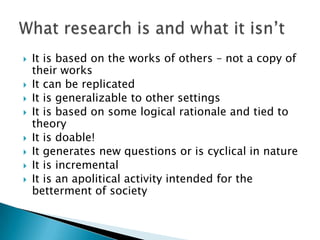
What research is and what it isn’t
- 1. It is based on the works of others – not a copy of their works It can be replicated It is generalizable to other settings It is based on some logical rationale and tied to theory It is doable! It generates new questions or is cyclical in nature It is incremental It is an apolitical activity intended for the betterment of society
- 2. NONEXPERIMENTAL 1. Descriptive – describe the characteristics of an existing phenomenon 2. Historical – relate events that have occurred in the past to current events 3. Correlational – examine the relationships between variables
- 3. EXPERIMENTAL – Test for true cause and effect relationships QUASI-EXPERIMENTAL – Test for causal relationships without having full control
- 4. Ask new questions Ask and Reconsider the identify Theory factors Test the Hypothesize Hypothesis Gather Data
- 5. 1. What areas within your discipline especially interest you? 2. Come up with 2 possible questions you could possibly work on within a period of 2 months. 3. Of the different types of research described and discussed, which one do you think best fits the type of research that is suited to answer your questions in #2?
- 6. Significance levels Null hypotheses Independent variables Factorial designs Samples Populations
- 7. VARIABLE – represents a class of outcomes that can take on more than one value example: HAIR COLOR (red, brown, blonde, …) Variables of the same name can take on different values example: HEIGHT (in actual measurement or in rank)
- 8. Represent the outcomes of a research study that may depend on the experimental treatment or on what the researcher changes or manipulates example: growth rate (increment in height) of monggo seedlings with different wavelengths of light
- 9. Represent the treatments or conditions that the researcher controls to test their effects on some outcome Also known as treatment variable Must take on at least two levels or values
- 10. General Rule: When the researcher is manipulating anything or assigning participants/samples to groups based on some characteristic, such as age, gender, or treatment, that variable is the independent variable.
- 11. In some cases, when the interest is not on the effects of one thing to another, but only in how variables may be related, there are no independent variables. NOTHING IS MANIPULATED
- 12. Factorial Designs – experiments that include more than one independent variables example: 1. Gender (male, female) 2. Age (1-3,4-6,7-9,10-12) 3. Health status (undernourished, normal, overweight)
- 13. The best independent variable is independent of any other variable in the same study in order to contribute the maximum amount of understanding beyond what other independent variables can offer The best dependent variable is one that is sensitive to changes in the different levels of the independent variable. Otherwise, even if the treatment had an effect, you’d never know it.
- 14. Control variables – has a potential influence on the dependent or variable and has to be removed or controlled Extraneous variable – has an unpredictable impact on the dependent variable Moderator variable – related to the variables of interest, masking the true relationship between the dependent and the independent
- 15. “educated guesses” Reflect the general problem statement or question that was the motivation for undertaking the research study Provide transition from a problem statement into a form that is more amenable to testing
- 16. a statement of equality: - There will be no difference… - There is no relationship… Refers to the population A starting point (state of affairs accepted as true in the absence of other information) A benchmark against which the actual outcomes of a study will be measured or compared to see if the difference is due to chance or something else
- 17. a definite statement of the relationship between two variables; explicit A statement of inequality – directional (more than or less than) and nondirectional (different from) It is this hypothesis that is tested directly (in a sample of a population) as one step in the research process
- 18. 1. Stated in declarative form and not as a question. 2. Clearly describes the relationship between variables. 3. Reflect the theory or literature they are based on. 4. Should be brief and to the point. 5. Testable.
- 19. Traditional approach: IDEA RESEARCH ? H1 LIT REVIEW Better approach: IDEA LIT REVIEW RESEARCH ? H1
- 20. Select a problem that you are genuinely interested in.
- 21. 1. Falling in love with your idea can be fatal. 2. Sticking with the 1st idea that comes to mind isn’t always wise. 3. Doing something trivial that has no conceptual basis or no apparent importance 4. Biting off more than you can chew. 5. Doing something that has already been done.
